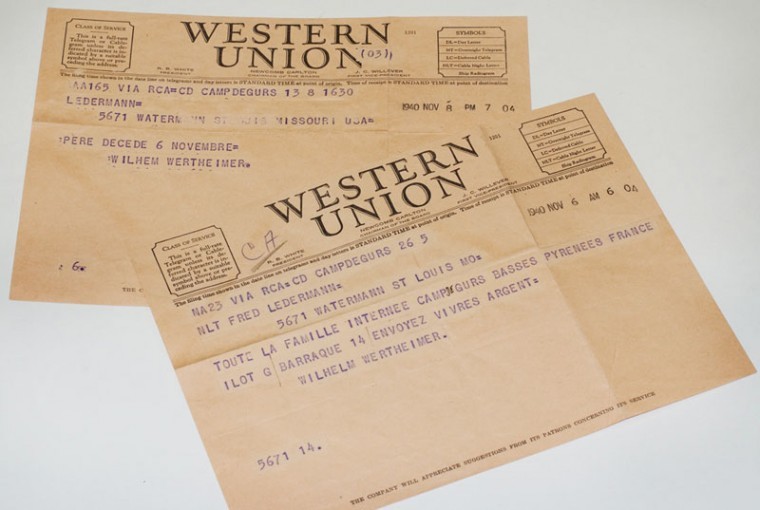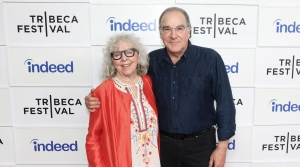Holocaust Museum opens new artifacts to researchers
Published January 26, 2011
A group of academicians will get to sample tangible evidence of the horrors of occupied Europe this week with a presentation on items found in the archives of the St. Louis Holocaust Museum and Learning Center. Led by Jewish community archivist Diane Everman, the display at the Kopolow Building will allow guests from the area’s universities and colleges to view a wealth of documents, photos, diaries, and other items of interest from Hitler’s Germany and its neighbors.
“If you are familiar with some of the items in the Holocaust Museum, that is literally the tip of the iceberg,” said Everman. “There is so much more, everything from manuscript materials to photographs to oral histories, material culture items that add depth to what is already in the museum.”
Everman said correspondence plays a major role in the archive. Some of it comes from concentration camps in the form of letters back home.
“For some of these letters at least it seemed like they didn’t know exactly what was happening or what was going to happen to them,” she said. “It was just ‘Yes, we’ve been sent here’ and that’s about it.”
But even more interesting letters are found. As the Nazis’ plans became increasingly clear, people found themselves trying to escape a nation in which they no longer felt safe or welcome.
“There are letters writing to relatives or even complete strangers because they needed a sponsor, they needed money, they needed assistance to get out,” said Everman. “The response was often, ‘I’m sorry, I can’t. I’m already sponsoring X number of people. I can’t do one more.’ We also had family members, even far-removed distant cousins, who did help people get out.”
Documents from the Nuremberg trials also figure into the archive. Two such collections from local residents Hedy Epstein and the late Whitney Harris are included in the materials.
“Even though a lot of it is available elsewhere, at least with Hedy and Whitney, there are other things, including an oral interview with Hedy and all kinds of additional information,” Everman said. “So if somebody is interested in doing research on that aspect of the post-war period and the trials those collections are just invaluable.”
Not only papers, but artifacts play a role in enlivening the archive. Even innocuous souvenirs can relate the story of a darkening political climate. “Tinnies,” small metal keepsakes designed to be embedded in a tourist’s walking stick as evidence of his or her travels, are one example.
“In the early times they were of a city or a cathedral or one of the Alps – something innocent,” she said. “Then later on, it seemed like the Nazi propaganda machine took over and it sort of mutated to things that had more militaristic or similar imagery on them.”
The objects weren’t the only commemorative Hitler’s forces used to push the message of National Socialism. Collectible cigarette packages consisting of photos on thin paper are another popular item. The pictures depict everything from the 1936 Berlin Olympics to Hitler in formal wear to troop movements. The idea seems to have been similar to collecting baseball cards in America.
“We have some that are loose but we also have entire albums that are filled with those images,” Everman said. “On the back they have all this information about which collection it is and what’s going on in the photograph, sort of a ‘collect all of them if you want to know more about what’s going on with the Reich’ kind of thing.”
It’s not always easy to gauge the historical significance of an item. A doll with a Star of David emblazoned on its back is one example. Originally, it was thought to be a potentially important Holocaust artifact but research changed the picture.
“We did a little snooping on it and the emblem on the back of the neck was just the logo used by the company that made them,” Everman said. “The company was around until about 1920 or 1930. It’s not specifically Jewish or anti-Jewish. There were lots of companies at the time that had that as their logo.”
Visual images aren’t left out either. Photographic work by liberators display the types of scenes they were exposed to upon coming into the camps.
“They show what they saw, what they experienced,” she said. “That’s a huge part of the photographic collection.”
Various other items round out the materials. From Hitler Youth documents to diaries to day planners to cantina money from Buchenwald, each artifact tells its own story. Much of the material is in Yiddish, Polish, French, German and other languages. Not all of the correspondence is from camps. Some came from communities in the United States, Denmark, Sweden and other countries where Jews sought refuge.
Others found even more exotic locales in which to shelter including China.
“Those are really interesting. I honestly didn’t know much about the Jewish community in Shanghai before the war but these collections have photographs, people’s diaries and letters back home about what life was like there, even the restaurants that were open and the theater groups that existed,” Everman said.
Everman thinks the academics and graduate students who view the documents and items will get an interesting sense for the kinds of research that can be done without having to travel.
“It really shows the type of material that’s available,” she said. “You don’t have to go far and wide. There are things right here they can work on.”
Jean Cavender, director of the HMLC, said that last year her organization received a grant from the Missouri Historical Records Grant Program. Michael and Carol Staenberg will underwrite Thursday’s event, which is being held in honor of International Holocaust Remembrance Day.
“The museum leadership thought what better way to honor those who suffered than to unveil its collections for the higher academic community and to let it be known that these archives are now available for use in research,” Cavender said.















